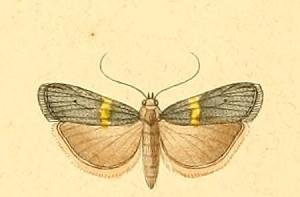
The Pyralidae, commonly called pyralid moths, snout moths or grass moths, are a family of Lepidoptera in the ditrysian superfamily Pyraloidea. In many classifications, the grass moths (Crambidae) are included in the Pyralidae as a subfamily, making the combined group one of the largest families in the Lepidoptera. The latest review by Eugene G. Munroe and Maria Alma Solis retain the Crambidae as a full family of Pyraloidea.

The mint moth is a small moth from the family Crambidae, also known by the common name Small Purple and Gold.

Cataclysta lemnata, the small china-mark, is a moth species of the family Crambidae. It is found in Europe, Morocco and Iran.

Elophila nymphaeata, the brown china mark, is a species of moth of the family Crambidae. It was described by Carl Linnaeus in his 1758 10th edition of Systema Naturae. It is found in Europe and across the Palearctic to the Russian Far East and China. The moth is notable as its larva, like most members of the crambid subfamily Acentropinae, is aquatic and has tracheal gills.

Oxybia is a monotypic snout moth genus described by Hans Rebel in 1901. Its only species, Oxybia transversella, was described by Philogène Auguste Joseph Duponchel in 1836. It is found in southern Europe and on the Canary Islands.

Orenaia alpestralis is a species of moth in the family Crambidae.
Nymphicula nigristriata is a moth in the family Crambidae. It was described by George Hampson in 1917. It is found on New Guinea and in the Solomon Islands.
Cynaeda dichroalis is a moth in the family Crambidae. It was described by George Hampson in 1903. It is found in Sri Lanka.
Tabidia strigiferalis is a moth in the family Crambidae. It is found in China, Korea and Russia.
Phaedropsis venadialis is a species of moth in the family Crambidae. It was described by Schaus in 1920. It is found in Mexico (Sinaloa).
Pygospila hyalotypa is a moth in the family Crambidae. It was described by Turner in 1908. It is found in Papua New Guinea and Australia, where it has been recorded from Queensland.
Samea delicata is a moth in the family Crambidae. It is found in Trinidad and Costa Rica.
Samea bipunctalis is a moth in the family Crambidae. It was described by Warren in 1888. It is found in Pakistan.
Sameodes alexalis is a moth in the family Crambidae. It is found in the Philippines (Luzon).
Sameodes ulricalis is a moth in the family Crambidae. It is found in the Philippines (Luzon).
Sameodes ennoduisalis is a moth in the family Crambidae. It is found in the Philippines (Luzon).
Sameodes enderythralis is a moth in the family Crambidae. It is found in India (Sikkim).
Tyspanodes flaviventer is a moth in the family Crambidae. It was described by Warren in 1891. It is found in India.
Ambia oligalis is a moth in the family Crambidae. It is found on the Louisiade Islands.
Ambia punctimarginata is a moth in the family Crambidae. It is found in Papua New Guinea.




